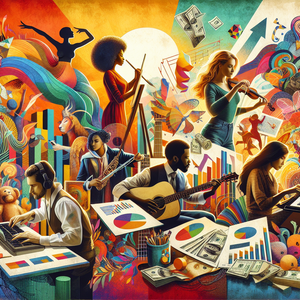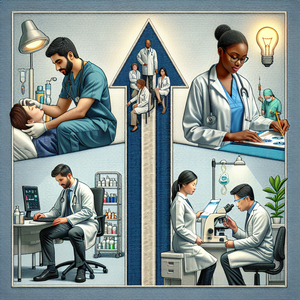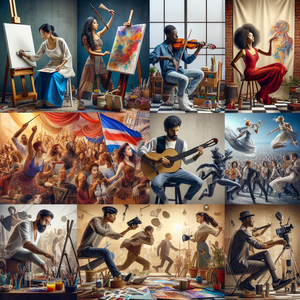
Exploring 20 Exciting Careers in the Arts: Roles, Earnings, and Future Prospects
The art and design sector is a vibrant arena brimming with diverse opportunities for creative minds. As our world becomes increasingly visual and digital, the demand for artistic talent is on the rise, paving the way for a variety of fulfilling careers. From animation and graphic design to art therapy and curatorship, the possibilities are vast. Employment in these fields is projected to grow steadily from 2023 to 2033, underscoring the essential role of visual communication in our daily lives. This article delves into 20 prominent art careers, outlining their key responsibilities, educational pathways, salary expectations, and future growth opportunities. With this comprehensive guide, aspiring artists can identify suitable roles that align with their interests and skills, while also gaining insights into industry trends and job prospects.
Job Summaries:
Animator:
- Animators craft captivating moving images and visual effects for various media, including films and video games.
- This involves skills in storyboarding and character design.
- A bachelor's degree in animation or a related field is typically required.
- The average annual salary is approximately $77,000, with job growth projected at 16% by 2031.
- Key skills include proficiency in software such as Adobe After Effects and Maya.
Graphic Designer:
- Graphic designers create visual concepts to enhance branding, advertising, and digital media.
- A degree in graphic design or a related discipline is necessary.
- The average salary is around $54,000, with growth expected to be 3% by 2031.
- Mastery of Adobe Creative Suite is a key skill.
Art Director:
- Art directors oversee the visual elements of projects.
- They lead teams to ensure cohesive execution of the project vision.
- A bachelor’s degree in art or design is required.
- Substantial industry experience is required.
- The average salary is $96,000.
- Projected growth rate is 4% by 2031.
- Strong leadership and strategic decision-making abilities are essential skills.
Illustrator:
- Illustrators create images for books, advertisements, and other media, often working as freelancers.
- A degree in illustration or fine arts can enhance credibility.
- The average annual income is $60,000, though freelance work can lead to significant variations.
- Expertise in both traditional and digital illustration techniques is crucial.
Fashion Designer:
- Fashion designers conceptualize and create clothing and accessories.
- They conduct market research and oversee production.
- A degree in fashion design or a related field is necessary.
- The average salary is $75,000.
- Growth projected at 5% by 2031.
- Strong drawing and sewing skills are important.
Curator:
- Curators manage art collections.
- Curators organize exhibitions.
- Curators engage with the public.
- A master’s degree in art history or museum studies is typically required.
- The average annual salary is $63,000.
- Growth expected to be 7% by 2031.
- Proficiency in research, organization, and communication is essential.
Art Teacher:
- Art teachers educate students in various artistic disciplines, fostering creativity and skill development.
- A bachelor’s degree in art education, along with state certification, is necessary.
- The average salary is $55,000, with projected growth of 4% by 2031.
- Effective teaching techniques and lesson planning are key skills.
Web Designer:
- Web designers create visually appealing and user-friendly websites that engage audiences effectively.
- A degree in web design or a related field is required.
- The average salary is $66,000, with a growth rate of 8% expected by 2031.
- Proficiency in HTML, CSS, and various design software is essential.
Art Therapist:
- Art therapists leverage creative processes to promote mental health and emotional expression.
- A master’s degree in art therapy or a related field, along with relevant certification, is necessary.
- The average salary is $60,000, with projected growth of 14% by 2031.
- Strong grasp of psychological principles and creative methodologies is crucial.
Interior Designer:
- Interior designers create functional and aesthetically pleasing spaces tailored to client needs.
- A degree in interior design is typically required.
- The average salary is $65,000, with projected growth of 4% by 2031.
- Knowledge of design principles and building codes is essential.
Fine Artist:
- Fine artists create original artworks across various mediums and exhibit them to the public.
- A bachelor’s degree in fine arts is common, though self-taught artists can also thrive.
- Income is highly variable, with an average around $50,000.
- A strong artistic vision and technical skills are important.
Photographer:
- Photographers capture images for storytelling, documentation, or artistic purposes.
- Formal education in photography can enhance skills and opportunities.
- The average salary is $45,000, with growth of 8% expected by 2031.
- Proficiency with cameras and editing software is essential.
Commercial Artist:
- Commercial artists create artwork for advertising and marketing materials.
- A background in graphic design or fine arts is beneficial.
- The average salary is $50,000, with growth projected at 3% by 2031.
- Strong creative and client-focused abilities are crucial.
Concept Artist:
- Concept artists develop visual representations for characters and environments in various media.
- A degree in art or a related field is advantageous.
- The average salary is $80,000, with growth expected at 7% by 2031.
- A robust portfolio and imaginative design capabilities are essential.
Art Handler:
- Art handlers transport and install artworks safely in galleries and museums.
- No formal education is required, but knowledge of art materials is essential.
- The average salary is $41,000, with growth projected at 6% by 2031.
- Attention to detail and physical stamina are key skills.
Textile Designer:
- Textile designers create patterns and designs for fabrics used in fashion and interiors.
- A degree in textile design or a related field is necessary.
- The average salary is $60,000, with projected growth of 4% by 2031.
- Strong artistic skills and trend research abilities are crucial.
Game Designer:
- Game designers create concepts for video games.
- They collaborate with programmers and artists.
- A degree in game design or a related field is required.
- The average salary is $80,000.
- Growth projected at 8% by 2031.
- Creativity and technical proficiency are essential.
Set Designer:
- Set designers create physical surroundings for film, theater, and television productions.
- A degree in set design or a related field is necessary.
- The average salary is $55,000, with expected growth of 4% by 2031.
- Creativity and meticulous attention to detail are key skills.
Art Marketing Specialist:
- Art marketing specialists promote artists and their work, managing marketing strategies and social media presence.
- A background in marketing or art is beneficial.
- The average salary is $60,000, with growth expected at 10% by 2031.
- Strong communication and marketing skills are essential.
Art Appraiser:
- Art appraisers evaluate and provide valuations for artworks.
- A degree in art history or a related field, along with pertinent certification, is necessary.
- The average salary is $65,000, with growth projected at 5% by 2031.
- Knowledge of art history and market trends is crucial.
The art and design industry offers a multitude of pathways for those eager to express their creativity and make a meaningful impact. Whether pursuing lucrative positions like animators and art directors or more fulfilling roles such as art teachers and therapists, there is a place for everyone. As the landscape of this industry evolves, aspiring artists are encouraged to explore available opportunities and acquire the necessary skills for success. By understanding the various art careers and their requirements, individuals can make informed choices and embark on rewarding journeys in the realm of creativity.
Explore More Jobs

